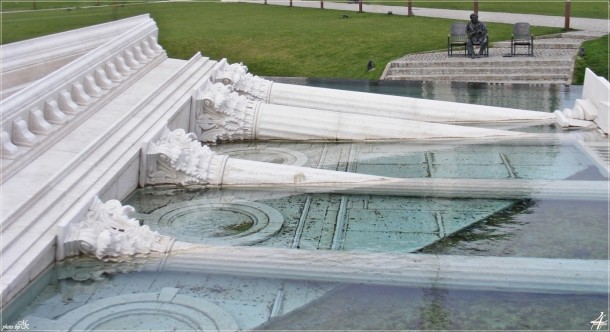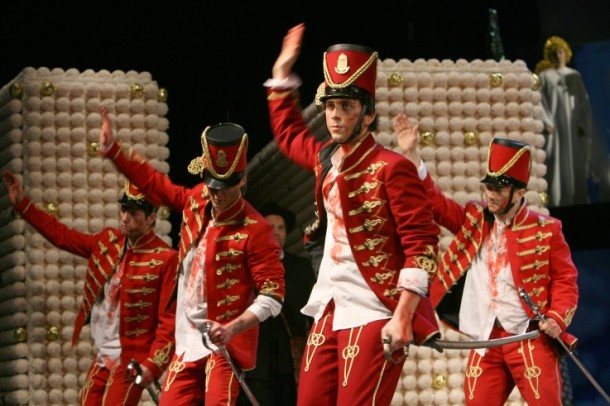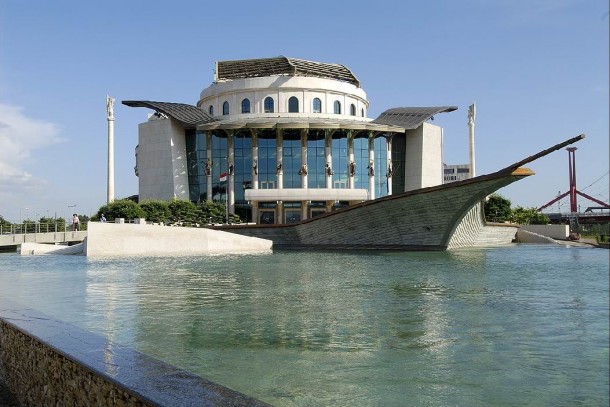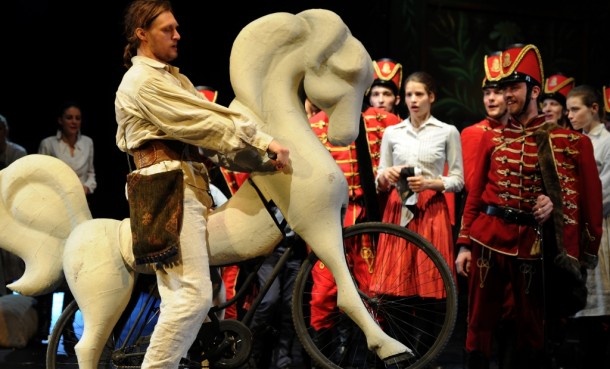The National Theatre in Budapest has been troubled by political and cultural cross-currents for the past years, which have left temporary marks on its audience, repertoire, and stagings as well as long-term marks on its physical structure. Let us begin with these more long-term effects, at the center of which is the theatre building itself. The story behind the construction of the present building is a long and depressing one. The government decided to blow up the deteriorating early nineteenth-century home of the National Theatre in 1965, and held an international design competition for its replacement. No first prize was given and official enthusiasm for the second prize was so slight that a building permit was not issued until 1985. The project was abandoned three years later. A new competition for designs was held and a new location chosen but it was not until 1996 that the Parliament actually approved the project. During the next few years political power struggles between the center-left and center right parties delayed the project, and excavations for the building had been completed when in 1998 the new center-right government of Viktor Orbán, declaring the project too costly, stopped it, leaving only a large hole in the middle of the city, which still exists today.
Since the new project was ultimately even more costly than the old, it has been often suggested that the new conservative government did not want the National Theatre to be located in the center of the city, which had a growing bohemian character, but rather in a more remote and pristine location in the suburbs. The site selected was one of the last remaining undeveloped areas near the city along the Danube on the Pest side. It was on a tract proposed for the projected World Exposition with Vienna, in 1996, which never came to fruition. With the failure of this project, the government began to plan for the site to be developed as a major new urban hub, with cultural centers, housing, hotels, and businesses, to be called the Millennium City Center. The Orbán government saw the National Theatre as a potential centerpiece of this development, along with a cultural center, somewhat as Lincoln Center in New York City was closely connected with urban development.
The major difference however was the Lincoln Center was already located in a developed urban area, albeit one of a lower class than developers desired, and moreover was well-integrated into the urban transportation system. Neither of these factors was present for the Millennium Center, nor was the financially strained government able to provide them. Even the railway line—which unfortunately separates the theatre from the river—does not have a stop here. Thus today, fifteen years after the ground was broken for the theatre and thirteen years after its opening, it and the adjoining cultural center stand almost alone, with no hotels, housing, or other commercial ventures anywhere nearby, only a row of partly occupied office buildings, in an area that seems largely desolate and deserted.
When the government decided to move ahead with the project in this new location it did not hold a competition for the design, as had been the previous practice, but commissioned Mária Siklós, who had never designed a theatre, to carry out the project. She created a building in what she called an “eclectic” style—actually an uneasy mixture of the most banal features of nineteenth-century monumental theatre design—festooned with nine giant golden art nouveau figures representing the muses, large grey wings extending from the roof and bizarre post-modern touches, neither integrated with the building nor making an interesting contrast with it. Several hundred yards in front of the building a ship’s prow rises from the earth, on the Danube side of the building there is a large hedge labyrinth adjoining a four story Ziggurat, in pure Babylonian style, with no planned purpose. Most fitting, symbolically, is a large pool on the other side of the building in which can be seen, half submerged, a full size replica of the entrance columns of the old national theatre.

Submerged columns in the pond beside the National Theatre, Budapest. Photo courtesy of the National Theatre.
Architectural critics have almost universally condemned the building and although not a specialist, I would unquestionably rank it as the ugliest major theatre I have ever seen anywhere in the world. The interior is less openly ugly, merely inefficient, with a jumble of stairways, no attractive public spaces, a vista from the main gathering hall that does not look out on the neighboring Danube but only the artificial park with its emerging ship’s prow, and dozens of odd little nooks and crannies containing obviously enormously expensive single little tables and chairs that clearly no one ever uses. When you add this catastrophic design to the unfortunate physical location, you have a toxic blend indeed.
Would that the theatre could offer happier news on its actual presentations, but unfortunately it cannot. Between 2008 and 2013, the National Theatre was directed by one of the most popular leaders in its almost two hundred year history, the actor and director Robert Alföldi. As the Orbán government has consolidated its power and moved further and further to the right, Alföldi’s unconventional and often politically and cultural daring productions made him one of the most visible targets for conservative wrath in Parliament. Perhaps not surprisingly, the last production he mounted before his removal, in June of 2013, was the Hungarian premiere of Tony Kushner’s Angels in America, directed by Andrei Serban and starring Alföldi himself as the AIDS-riddled hero. The production was sold out for its entire run, with star and production receiving standing ovations nightly, and proved the final straw for Alföldi’s enemies in Parliament.
He was replaced by a known right-wing director, Attila Vidnyánszky, the director of the National Theate in Debrecen, Hungary’s second-largest city, who assumed the post vowing to restore the theatre to its folk roots and its “sacred mission.” The results of this were clearly apparent in the production I attended there in May of 2015, one of his most ambitious. It was a staging of a key work in the Hungarian canon, the folk epic of John the Valiant, a Hungarian figure very similar to Ibsen’s Peer Gynt.
John the Valiant has been performed frequently on the Hungarian stage, as children’s theatre, epic drama, and musical, and it is perfectly suited to the current director’s stated goal of returning the national theatre to its folk roots. It is all the more appropriate in that his unconventional predecessor, in a move typical of his challenging of tired conventions, created a new version of this familiar work which was dark, cruel, and full of material both shocking and offensive to many who had grown up with the work as a light-hearted picaresque folk tale. Perhaps most shocking was the conclusion. Like Peer Gynt, John wanders the world having left behind his one true love, the faithful Iluska. Unlike Peer, however, when John finally returns home after a life of adventures, he finds his love dead and buried. John’s tale does not end there, however. He plucks a rose from the grave of his beloved and resumes his wanderings, coming at last to fairyland. There he finds a magic lake into which he throws the flower which miraculously turns into the lost Iluska and the story ends with them ruling “to this very day” as the King and Queen of Fairyland.
In a darkly ironic comment on this familiar and conventional ending, Alföldi took his hero (played by himself) from the grave of his dead love not to fairyland, but to a run-down and tawdry red-light district of a city suspiciously reminiscent of Budapest itself. There, among the whores, somewhat suggestive of figures from Brecht’s Threepenny Opera, he finds a prostitute who to his troubled mind seems to be his lost Iluska. He gives her the rose as a corsage and they dance off together into a kind of grotesque carnival.
Nothing could be more suitable to the new director’s mission of restoring sanctity to the National Theatre than a complete restaging of this classic work, returning it to the light-hearted and warm piece of folk entertainment that it had been before this unfortunate reinterpretation. The production I saw was calculatedly charming, opening with children gathered in a toy room to read the familiar stories, with colorful characters popping out of a large and ornate toy box when needed, much like the figures in the cartoon film Toy Story. Handsome soldiers, village maidens in colorful traditional costumes, and charmingly cut-out story-book like scenery whirled through a series of spirited dances and engaging encounters with clearly unthreatening comic book bandits, giants, and witches.
The stage was often covered with figures, but the composition was generally unclear and the dance sequence uneven, since the director had sought to emphasize the popular element of the production by extensive use of chorus members and dance groups from local schools. This had a certain charm at first, but as the production continued through scene after scene played with similar energy and similar pictorial elements (the production lasted over three hours), I found it harder and harder to maintain my interest. Clearly this was not simply a problem of my difficulty with the language, since in sharp contrast to the spectacularly successful version of Alföldi, this staging was playing to a half-empty house, and that house made up largely of groups of school children whose buses were almost the only vehicles in the large parking lot behind the theatre. Not surprisingly, after an hour or so, it was clear from the talking and rustling in the house that this audience was no more enthusiastic than I was. I must assume that the hope of the production was surely to help develop a sense of pride in the national cultural tradition among the country’s youth, surely an excellent concern for a national theatre, but I really saw no evidence that anything of the sort was occurring.
Marvin Carlson, Sidney E. Cohn Professor of Theatre at the City University of New York Graduate Center, is the author of many articles on theatrical theory and European theatre history, and dramatic literature. He is the 1994 recipient of the George Jean Nathan Award for dramatic criticism and the 1999 recipient of the American Society for Theatre Research Distinguished Scholar Award. His book The Haunted Stage: The Theatre as Memory Machine, which came out from University of Michigan Press in 2001, received the Callaway Prize. In 2005 he received an honorary doctorate from the University of Athens. His most recent book is The Theatres of Morocco, Algeria and Tunisia with Khalid Amine (Palgrave, 2012).
European Stages, vol. 5, no. 1 (Fall 2015)
Editorial Board:
Marvin Carlson, Senior Editor, Founder
Krystyna Illakowicz, Co-Editor
Dominika Laster, Co-Editor
Editorial Staff:
Elyse Singer, Managing Editor
Clio Unger, Editorial Assistant
Advisory Board:
Joshua Abrams
Christopher Balme
Maria Delgado
Allen Kuharsky
Bryce Lease
Jennifer Parker-Starbuck
Magda Romańska
Laurence Senelick
Daniele Vianello
Phyllis Zatlin
Table of Contents:
- Avignon the 69th Festival, July 4 to 25, 2015: Discovery Beyond The Classics by Philippa Wehle
- The 2015 Oslo International Festival at Black Box Theatre by Andrew Friedman
- The 2015 Theatertreffen by Marvin Carlson
- A Feminist Tuberculosis Melodrama: Melek by Theatre Painted Bird by Emre Erdem
- Nachtasyl at the Berliner Schaubühne: A Radical View of Gorky’s The Lower Depths by Beate Hein Bennett
- From Spectacular to Minimalist: Four Plays in Madrid, April 2015 by Phyllis Zatlin
- European productions at Montreal’s Transamériques Festival 2015 by Philippa Wehle
- Childish or Adult? Recent productions in Germany by Roy Kift
- Russian Drama in Finland by Pirkko Koski
- Troubling Cross-Currents in the Budapest National Theatre by Marvin Carlson
- Spain: Engaging with la Crisis Through Theatre by Maria Delgado
- Life and Death in the Emergency Room: Linus Tunström’s Faust 1 at the Staatsschauspiel Dresden by Bryce Lease
Martin E. Segal Theatre Center:
Frank Hentschker, Executive Director
Marvin Carlson, Director of Publications
Rebecca Sheahan, Managing Director
©2015 by Martin E. Segal Theatre Center
The Graduate Center CUNY Graduate Center
365 Fifth Avenue
New York NY 10016






